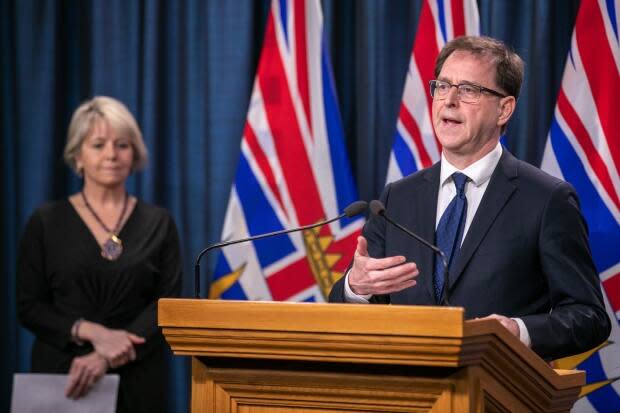Here — once again — is why B.C. isn't planning on increasing restrictions soon

Weeks into B.C.'s third wave, with cases still around 1,000 a day and hospitalizations still increasing to new heights every day, there are some who would like the government to do more.
"It seems like the government is responding quite passively," said Green Party Leader Sonia Furstenau.
A week after the government put in new restrictions on indoor dining and religious services, Furstenau called for further restrictions, including closing schools, non-essential businesses and enforcing a non-essential travel ban through roadblocks.
The response from the government has been a defence of the new status quo.
"We need a ferry system and the idea that we can shut it down or dramatically limit it, I think wouldn't be in the best interest of Vancouver Island," said Health Minister Adrian Dix on CBC's On The Island on Friday, one of several interviews he did on CBC radio stations on Friday where he defended the current restrictions.
Of course, Dix did the same thing three Fridays ago, and then by Monday, new restrictions were in place. A lot can change in a few days, as Ontario has just shown.
But at least for now, here's why the government believes its approach is working.
Cases, hospitalizations, deaths
"I just want this information to be out there so that people understand how we are making some of those decisions, sometimes very rapidly, as we see developing cases happen in different communities around the province," said Provincial Health Officer Dr. Bonnie Henry on Thursday.
"Going back to some of our epidemiological data, this is: daily cases, hospitalizations and deaths."
Each of those three metrics tells a slightly different story at the moment.
Daily deaths have approximately doubled since a low point in the middle of March — but because people over 80 by and large aren't being infected due to vaccines, it's still 75 per cent below the height of the second wave in B.C., at around four a day.
Daily cases have also doubled in the last month, from around 550 a day to 1,100. But the province was hopeful that the rapid increase in new cases would slow down a couple of weeks after its new measures were put in place, and that appears to have happened, at least for the last few days.
But it's hospitalizations that are the biggest concern. People in critical care with active cases have nearly doubled in the last five weeks as well, from 67 on March 12 to 127 on Friday.
Because hospitalizations typically lag behind cases, that number will likely go up for a few days, even if daily cases remain steady. And a small but real percentage of people in their 20s and 30s require hospitalization when infected — around one per cent of 20-somethings and 2.5 per cent of 30-somethings — and most of them won't get their first shot for another month or two.
"We need to take a multi-pronged approach, because the transmission increase is enough to cause a problem," said Caroline Colijn, head of the B.C. COVID-19 Modelling Group that just released a report warning of the potential of thousands of people in hospital based on rates of growth in March.
She said that if trend lines continue, the decreasing number of very elderly people in hospitals due to vaccinations could quickly be replaced by a surge among younger generations.
"It doesn't balance out enough. It's not low enough risk in young people that it's just OK to proceed [as normal]."
The government declined a request by CBC News for a total list of available beds for COVID-19 patients per hospital and said it did not have a specific number or percentage of filled beds it used as a metric to determine what level would be concerning enough for new restrictions.
Big decreases in vaccinated cohorts
The province also continues to repeat the message that vaccinations will slowly turn the tide.
"This is a period now, between now and the end of June, when everyone will have the opportunity to be vaccinated, where the risk is high," said Dix.
Data provided by the government bears out the success so far of vaccines among different groups that have received universal access to a first dose.
Active First Nations COVID-19 cases in B.C. are down 78 per cent from their peak in January. Weekly cases in Prince Rupert are down 77 per cent from their peak, two weeks after 85 per cent of the community was vaccinated. Daily cases among people over the age of 80 are down 75 per cent from the peak of the second wave.
That still leaves the general population as a whole waiting for a few more weeks. And a province waiting for another week or two to see if its current approach can hold.
"After a year, people are tired of this," acknowledged Dix.
"We see light at the end of the tunnel for two months. But we really have to look at those rules, look at our social interactions and limit them, because that's how we make ourselves safer as individuals and as a community."

